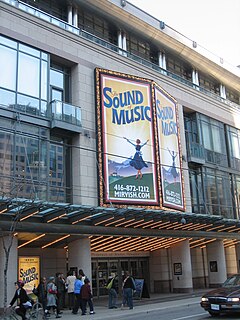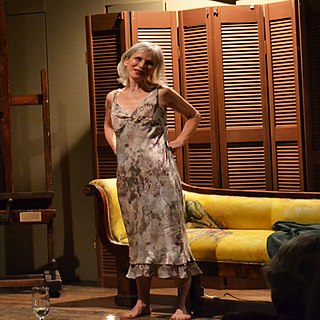
Canada's contemporary theatre reflects a rich diversity of regional and cultural identities. Since the late 1960s, there has been a concerted effort to develop the voice of the 'Canadian playwright', which is reflected in the nationally focused programming of many of the country's theatres. Within this 'Canadian voice' are a plurality of perspectives - that of the First Nations, new immigrants, French Canadians, sexual minorities, etc. - and a multitude of theatre companies have been created to specifically service and support these voices.
The Toronto Fringe Festival is an annual theatre festival, featuring un-juried plays by unknown or well-known artists, taking place in the theatres of Toronto, Ontario, Canada. Several productions originally mounted at the Fringe have later been remounted for larger audiences, including the Tony Award-winning musical The Drowsy Chaperone.

Daniel MacIvor is a Canadian actor, playwright, theatre director, and film director. He is probably best known for his acting roles in independent films and the sitcom Twitch City.

The Royal Alexandra Theatre, commonly known as the Royal Alex, is a theatre in Toronto, Ontario, located near King and Simcoe Street. Built in 1907, the 1,244-seat Royal Alex is the oldest continuously operating legitimate theatre in North America.

The Princess of Wales Theatre is a 2,000-seat live theatre in Toronto, Ontario, Canada. It is located on King Street West, in Toronto's downtown Entertainment District. The theatre's name has a triple meaning: it honours Diana, Princess of Wales, with whose consent the theatre was named; it links the building to its sister theatre, the Royal Alexandra, one block to the east, also named – with Royal assent – for a former Princess of Wales; and it recalls the Princess Theatre, Toronto's first "first-class legitimate" playhouse, that stood three blocks to the east until 1931.

Thomas White Lamb (1871–1942) was a Scottish-born, American architect. He was one of the foremost designers of theaters and cinemas in the 20th century.

The Elgin and Winter Garden Theatres are a pair of stacked theatres in Toronto, Ontario, Canada. The Winter Garden Theatre is seven storeys above the Elgin Theatre. They are the last surviving Edwardian stacked theatres in the world.
Judith Clare Thompson, OC F.R.S. is a Canadian playwright who lives in Toronto, Ontario. She has twice been awarded the Governor General's Award for drama, and is the recipient of many other awards including the Order of Canada, the Walter Carsen Performing Arts Award, the Toronto Arts Award, The Epilepsy Ontario Award, The B'nai B'rith Award, the Dora, the Chalmers, the Susan Smith Blackburn Award and the Amnesty International Freedom of Expression Award, both for Palace of the End, which premiered at Canadian Stage, and has been produced all over the world in many languages. She has received honorary doctorates from Thorneloe University and, in Nov. 2016, Queen's University in Kingston, Ontario.

Toronto is the largest city of Canada and one of the most multicultural cities in the world. Many immigrant cultures have brought their traditions languages and music to Toronto.

Nicky Guadagni is a Canadian actress who has worked on stage, radio, film and television.
The Drawer Boy is a play by Michael Healey. It is a two-act play set in 1972 on a farm near Clinton, Ontario. There are only three characters: the farm's two owners, Morgan and Angus, and Miles Potter, a young actor from Toronto doing research for a collectively created theatre piece about farming.

Downtown Toronto is the main central business district of Toronto, Ontario, Canada. Located entirely within the district of Old Toronto, it is approximately 16.6 square kilometres in area, bounded by Bloor Street to the northeast and Dupont Street to the northwest, Lake Ontario to the south, the Don Valley to the east, and Bathurst Street to the west. It is also the home of the municipal government of Toronto and the Government of Ontario.
Mark Brownell is a Toronto-based playwright and co-artistic director of the Pea Green Theatre Group with his wife, Sue Miner.

David Christopher Richards, best known as Christopher Richards is a Canadian playwright, theatre designer and casting director.
Robert Tsonos is a Canadian theatre director, actor, and playwright. He has acted in, or directed, over 60 productions across Canada, Japan, England, Venezuela, Hong Kong, and Australia during his 28-year career. He was the Artistic Director of Sometimes Y Theatre from 1997 to 2014, was the resident director at the Canadian Embassy Theatre in Tokyo from 2003-2006, and is currently the Artistic Director of Watermark Theatre in Prince Edward Island.
Toronto Alliance for the Performing Arts (TAPA) is an arts service organization representing professional theatre, dance and opera companies in the City of Toronto. Amongst their 175 members are the Canadian Opera Company, Luminato, Factory Theatre, Mirvish Productions, and Theatre Passe Muraille. As a lobby and advocacy group, it has been credited with playing a major role in raising Toronto's theatrical profile. TAPA also presents the annual Dora Mavor Moore Awards, operates T.O. TIX, and publishes Go Live Toronto, an online guide to theatre, dance and opera performances in the city. In 2008, the organization published a detailed survey of Toronto's performing arts groups, the first of its kind to be conducted there.
The Cheshire Unicorn is a theatre production company based in Toronto, Ontario. Founded by playwright Melissa Major in 2002, the company produces experimental theatre by Canadian artists. In addition to Melissa Major who writes, directs, and performs for the company, founding members include performers Emily Andrews and Justin Bott, producers Timna Bellari and Veronica Campbell, designers Scott Penner and Emily C. Porter, musicians Jamie Drake, Eric Patterson, Lily Ling and Jordann Zaza, and playwright Laura Burns. While the company primarily produces full-scale plays and musicals, it produced three cabarets in 2008, and curated two art shows in 2007.

Patrick Kwok-Choon is a Canadian actor, best known for his recurring roles as Perry Crofte in the television adaptation of the horror Western comic book miniseries Wynonna Earp and as lieutenant commander Gen Rhys in the CBS science fiction drama Star Trek: Discovery.
Ronald Pederson is a Canadian (Métis) actor, comedian and theatre director who has worked extensively throughout Canada and in the United States. He has performed with most of Canada's major theatres including The Stratford Festival, The Royal Manitoba Theatre Centre, The Citadel Theatre, Alberta Theatre Projects, The Arts Club, The Vancouver Playhouse, The Young Centre, The Canadian Stage Company, The Tarragon Theatre, Theatre Passe Muraille, Soulpepper and The SummerWorks Festival. Pederson has also worked extensively in television and may be best known for his Canadian Comedy Award-Nominated work and his three seasons on Fox Television's MADtv.
Layne Coleman is a Canadian actor, playwright and theatre director, most noted as a former artistic director of Theatre Passe Muraille. Originally from North Battleford, Saskatchewan, he first became prominent as a cofounder and artistic director of the 25th Street Theatre in Saskatoon in the 1980s.















